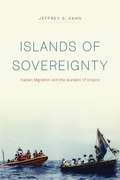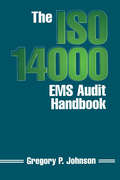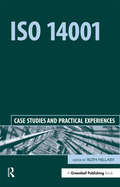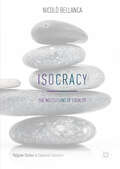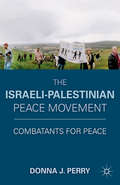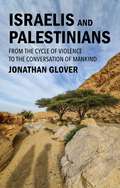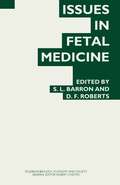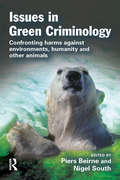- Table View
- List View
Islands of Sovereignty: Haitian Migration and the Borders of Empire (Chicago Series in Law and Society)
by Jeffrey S. KahnIn Islands of Sovereignty, anthropologist and legal scholar Jeffrey S. Kahn offers a new interpretation of the transformation of US borders during the late twentieth century and its implications for our understanding of the nation-state as a legal and political form. Kahn takes us on a voyage into the immigration tribunals of South Florida, the Coast Guard vessels patrolling the northern Caribbean, and the camps of Guantánamo Bay—once the world’s largest US-operated migrant detention facility—to explore how litigation concerning the fate of Haitian asylum seekers gave birth to a novel paradigm of offshore oceanic migration policing. Combining ethnography—in Haiti, at Guantánamo, and alongside US migration patrols in the Caribbean—with in-depth archival research, Kahn expounds a nuanced theory of liberal empire’s dynamic tensions and its racialized geographies of securitization. An innovative historical anthropology of the modern legal imagination, Islands of Sovereignty forces us to reconsider the significance of the rise of the current US immigration border and its relation to broader shifts in the legal infrastructure of contemporary nation-states across the globe.
Islands of Sovereignty: Haitian Migration and the Borders of Empire (Chicago Series in Law and Society)
by Jeffrey S. KahnIn Islands of Sovereignty, anthropologist and legal scholar Jeffrey S. Kahn offers a new interpretation of the transformation of US borders during the late twentieth century and its implications for our understanding of the nation-state as a legal and political form. Kahn takes us on a voyage into the immigration tribunals of South Florida, the Coast Guard vessels patrolling the northern Caribbean, and the camps of Guantánamo Bay—once the world’s largest US-operated migrant detention facility—to explore how litigation concerning the fate of Haitian asylum seekers gave birth to a novel paradigm of offshore oceanic migration policing. Combining ethnography—in Haiti, at Guantánamo, and alongside US migration patrols in the Caribbean—with in-depth archival research, Kahn expounds a nuanced theory of liberal empire’s dynamic tensions and its racialized geographies of securitization. An innovative historical anthropology of the modern legal imagination, Islands of Sovereignty forces us to reconsider the significance of the rise of the current US immigration border and its relation to broader shifts in the legal infrastructure of contemporary nation-states across the globe.
The ISM Code: A Practical Guide To The Legal And Insurance Implications (Lloyd's Practical Shipping Guides)
by Phil AndersonThe ISM Code has been mandatory for almost every commercial vessel in the world for more than a decade and nearly two decades for high risk vessels, yet there is very little case law in this area. Consequently, there remains a great deal of confusion about the potential legal and insurance implications of the Code. This third edition represents a major re-write and addresses significant amendments that were made to the ISM Code on 1st July 2010 and 1st January 2015. This book provides practitioners with a practical overview of, and much needed guidance on, the potential implications of failing to implement the requirements of the Code. It will be hugely valuable to DPAs, managers of ship operating companies, ship masters, maritime lawyers and insurance claims staff.
The ISM Code: A Practical Guide To The Legal And Insurance Implications (Lloyd's Practical Shipping Guides)
by Phil AndersonThe ISM Code has been mandatory for almost every commercial vessel in the world for more than a decade and nearly two decades for high risk vessels, yet there is very little case law in this area. Consequently, there remains a great deal of confusion about the potential legal and insurance implications of the Code. This third edition represents a major re-write and addresses significant amendments that were made to the ISM Code on 1st July 2010 and 1st January 2015. This book provides practitioners with a practical overview of, and much needed guidance on, the potential implications of failing to implement the requirements of the Code. It will be hugely valuable to DPAs, managers of ship operating companies, ship masters, maritime lawyers and insurance claims staff.
The ISO 14000 EMS Audit Handbook
by Greg JohnsonThe ISO 14000 EMS Audit Handbook is an innovative and cost-effective approach for the Environmental Management System (EMS) audit to ISO 14001. The Handbook presents comprehensive strategies for conducting all phases of the EMS audit, including effective assessment processes for determining improved environmental performance.
The ISO 14000 EMS Audit Handbook
by Greg JohnsonThe ISO 14000 EMS Audit Handbook is an innovative and cost-effective approach for the Environmental Management System (EMS) audit to ISO 14001. The Handbook presents comprehensive strategies for conducting all phases of the EMS audit, including effective assessment processes for determining improved environmental performance.
ISO 14001: Case Studies and Practical Experiences
by Ruth HillaryISO 14001 is the star standard among the International Organization for Standardization's ISO 14000 series of environmental management standards. It has seen spectacular growth since its launch in September 1996. Worldwide registrations are set to pass the 20,000 mark in 2000 with 20 times that number reportedly waiting in the wings.In 30 explicit but concise chapters, ISO 14001: Case Studies and Practical Experiences seeks to unravel the truth behind what can and cannot be achieved by ISO 14001 and aims to provide readers with enough knowledge to make choices about its relevance and importance not only to their worlds but also to society. Written by leading practitioners, certifiers, consultants, government and academics, the book examines both the real benefits and the shortcomings organizations have experienced with ISO 14001. We learn from both.Far more ambitious than an implementation guide, the book will provide those readers struggling with the standard first-hand experiences of the real issues they will face in implementing their EMS and, just as importantly, what certifiers look for when they visit firms. ISO 14001: Case Studies and Practical Experiences is a warts-and-all expose of ISO 14001: the issues tackled; the problems faced and overcome; and, above all, the astonishing flexibility of its uses and the diversity of its users.This important book is a must for businesses, researchers, consultants, government officials, students, NGOs and support organisations who want more than just another how-to-do-it manual; but rather the truth about how ISO 14001 is really working on the ground.
ISO 14001: Case Studies and Practical Experiences
by Ruth HillaryISO 14001 is the star standard among the International Organization for Standardization's ISO 14000 series of environmental management standards. It has seen spectacular growth since its launch in September 1996. Worldwide registrations are set to pass the 20,000 mark in 2000 with 20 times that number reportedly waiting in the wings.In 30 explicit but concise chapters, ISO 14001: Case Studies and Practical Experiences seeks to unravel the truth behind what can and cannot be achieved by ISO 14001 and aims to provide readers with enough knowledge to make choices about its relevance and importance not only to their worlds but also to society. Written by leading practitioners, certifiers, consultants, government and academics, the book examines both the real benefits and the shortcomings organizations have experienced with ISO 14001. We learn from both.Far more ambitious than an implementation guide, the book will provide those readers struggling with the standard first-hand experiences of the real issues they will face in implementing their EMS and, just as importantly, what certifiers look for when they visit firms. ISO 14001: Case Studies and Practical Experiences is a warts-and-all expose of ISO 14001: the issues tackled; the problems faced and overcome; and, above all, the astonishing flexibility of its uses and the diversity of its users.This important book is a must for businesses, researchers, consultants, government officials, students, NGOs and support organisations who want more than just another how-to-do-it manual; but rather the truth about how ISO 14001 is really working on the ground.
ISO 14001 and Beyond: Environmental Management Systems in the Real World
by Sheldon ChristopherOn September 1st 1996, ISO 14001 was published, worldwide. Written over five years in consultation with international industrial experts, non-governmental organizations and regulators, this environmental management systems standard will help organizations manage their impacts on the environment, no matter what their size, nature or location. The implications for the future are enormous. But what does the standard mean in the real world? What changes do managers have to make to accommodate its principles? What decisions need to be faced and when? Is it really going to make a difference or is it just another case of global greenwash? Will it be another missed opportunity for you, your organisation, or your market? At the start of what promises to be a worldwide explosion of interest in standardised EMSs, ISO 14001 and Beyond looks at their creation, their use, and their limitations, attempting to discover the essential truth about this important management tool and where it will take industry. ISO 14001 and Beyond assembles the leading thinkers and practitioners in the field to record their thoughts and experiences on the new standard, its advantages and disadvantages. The book is designed to provide the reader with enough information with which to form an opinion on the future, and how that will influence subsequent actions. It also provides reassurance that, although the problems are real, so are the solutions. ISO 14001 and Beyond gives you the opportunity to read what some of the best minds have made of the standard so far and what they think lies ahead. There are reports covering a global spectrum of concern: from the US, Russia, Japan, Canada, Germany, the UK, and more; from multinationals, small- and medium-sized enterprises, local government, universities and professional bodies. All this material is gathered together in one book to give you the best, most meaningful information for the crucial decisions that you will need to make in the coming months.
ISO 14001 and Beyond: Environmental Management Systems in the Real World
by Sheldon ChristopherOn September 1st 1996, ISO 14001 was published, worldwide. Written over five years in consultation with international industrial experts, non-governmental organizations and regulators, this environmental management systems standard will help organizations manage their impacts on the environment, no matter what their size, nature or location. The implications for the future are enormous. But what does the standard mean in the real world? What changes do managers have to make to accommodate its principles? What decisions need to be faced and when? Is it really going to make a difference or is it just another case of global greenwash? Will it be another missed opportunity for you, your organisation, or your market? At the start of what promises to be a worldwide explosion of interest in standardised EMSs, ISO 14001 and Beyond looks at their creation, their use, and their limitations, attempting to discover the essential truth about this important management tool and where it will take industry. ISO 14001 and Beyond assembles the leading thinkers and practitioners in the field to record their thoughts and experiences on the new standard, its advantages and disadvantages. The book is designed to provide the reader with enough information with which to form an opinion on the future, and how that will influence subsequent actions. It also provides reassurance that, although the problems are real, so are the solutions. ISO 14001 and Beyond gives you the opportunity to read what some of the best minds have made of the standard so far and what they think lies ahead. There are reports covering a global spectrum of concern: from the US, Russia, Japan, Canada, Germany, the UK, and more; from multinationals, small- and medium-sized enterprises, local government, universities and professional bodies. All this material is gathered together in one book to give you the best, most meaningful information for the crucial decisions that you will need to make in the coming months.
ISO 26000: The Business Guide to the New Standard on Social Responsibility
by Lars Moratis Timo CochiusOver the last ten years, Corporate Social Responsibility (CSR) has grown from being criticised as a management fad to being endorsed as good business practice by the majority of the world's leading companies. It has also become ever more complex; and the majority of companies are now in need of clarity and guidance to actively engage with CSR in practice, to develop strategies that reflect the unique context in which each company operates and to embed CSR within their values. ISO, the International Organization for Standardization, began developing an International Standard providing guidelines for social responsibility (SR) in 2005. This long-awaited guidance standard was finally published in November, 2010 as ISO 26000. Developed by stakeholders from industry, government, labour, consumers, non-governmental organizations and others, ISO 26000 will almost certainly become the single most authoritative worldwide standard for SR. In only a few years' time, many thousands of organizations around the world are likely to be using ISO 26000 as a foundation for their SR policies. ISO 26000 is voluntary, and includes no specific requirements; therefore it is not a certification standard. Nonetheless, business users in particular are anxious to measure against the new ISO guideline their current efforts at implementing SR issues within their overall business strategy. Furthermore, many organizations have indicated that they may reformulate current strategies or develop new initiatives based on the content of ISO 26000. This book, written by international experts who have closely followed the development of ISO 26000, is the first to provide potential users with a comprehensive roadmap to the new standard and a compass to identify where they stand in relation to it now. ISO 26000 defines all of the key terminology of SR, provides advice about the ways in which organizations can identify their social responsibilities and how SR can be integrated not only into companies, but into all types of organizations. It is not another code or norm, but an overarching blueprint for social responsibility. This book covers all the key content of ISO 26000, examining the development of the standard, the topics covered and how key themes such as stakeholders are dealt with. It is rich in tools and benchmarking exercises, illustrative material, case examples, and help for companies looking to base their CSR policy on ISO 26000. It also contains an overview of the actions and expectations of organizations that wish to work in accordance with ISO 26000. Timely, detailed and practical, ISO 26000: The Business Guide to the New Standard on Social Responsibility will be an essential resource for the thousands of organizations that need an expert view on how the new standard works, where they stand in relation to it, and how they can work towards developing their CSR efforts in line with its content.
ISO 26000: The Business Guide to the New Standard on Social Responsibility (Csr, Sustainability, Ethics And Governance Ser.)
by Lars Moratis Timo CochiusOver the last ten years, Corporate Social Responsibility (CSR) has grown from being criticised as a management fad to being endorsed as good business practice by the majority of the world's leading companies. It has also become ever more complex; and the majority of companies are now in need of clarity and guidance to actively engage with CSR in practice, to develop strategies that reflect the unique context in which each company operates and to embed CSR within their values. ISO, the International Organization for Standardization, began developing an International Standard providing guidelines for social responsibility (SR) in 2005. This long-awaited guidance standard was finally published in November, 2010 as ISO 26000. Developed by stakeholders from industry, government, labour, consumers, non-governmental organizations and others, ISO 26000 will almost certainly become the single most authoritative worldwide standard for SR. In only a few years' time, many thousands of organizations around the world are likely to be using ISO 26000 as a foundation for their SR policies. ISO 26000 is voluntary, and includes no specific requirements; therefore it is not a certification standard. Nonetheless, business users in particular are anxious to measure against the new ISO guideline their current efforts at implementing SR issues within their overall business strategy. Furthermore, many organizations have indicated that they may reformulate current strategies or develop new initiatives based on the content of ISO 26000. This book, written by international experts who have closely followed the development of ISO 26000, is the first to provide potential users with a comprehensive roadmap to the new standard and a compass to identify where they stand in relation to it now. ISO 26000 defines all of the key terminology of SR, provides advice about the ways in which organizations can identify their social responsibilities and how SR can be integrated not only into companies, but into all types of organizations. It is not another code or norm, but an overarching blueprint for social responsibility. This book covers all the key content of ISO 26000, examining the development of the standard, the topics covered and how key themes such as stakeholders are dealt with. It is rich in tools and benchmarking exercises, illustrative material, case examples, and help for companies looking to base their CSR policy on ISO 26000. It also contains an overview of the actions and expectations of organizations that wish to work in accordance with ISO 26000. Timely, detailed and practical, ISO 26000: The Business Guide to the New Standard on Social Responsibility will be an essential resource for the thousands of organizations that need an expert view on how the new standard works, where they stand in relation to it, and how they can work towards developing their CSR efforts in line with its content.
ISO 26000 - A Standardized View on Corporate Social Responsibility: Practices, Cases and Controversies (CSR, Sustainability, Ethics & Governance)
by Samuel O. Idowu Catalina Sitnikov Lars MoratisThis book provides a comprehensive and detailed introduction to the ISO 26000 standard for social responsibility (SR) in businesses and corporations. In addition to discussing the standard’s focus on various stakeholders and seven core topics, the book underscores its key aspects and most debatable issues, with a focus on its connection to sustainable business practices. It presents numerous cases and practical examples of the ISO 26000’s implementation and discusses the outcomes and lessons learned, in terms of the extent to which organizations can envision practicing CSR in ways that fit their activities, stakeholders and environment. Lately, the ISO 26000 has proved to offer an interesting and important approach to the standardization of (corporate) social responsibility. Approached and perceived as a voluntary standard that does not include any specific requirements, determining the best way to implement and work with it involved a considerable amount of experimentation. This book showcases the current state of application and discusses how different countries have developed their own specific versions of the standard, which organizations can use to certify their SR processes.
Isocracy: The Institutions of Equality (Palgrave Studies in Classical Liberalism)
by Nicolò BellancaIn the twentieth century there were two great political and social paradigms, the liberal-democratic and the libertarian (in its various socialist, anarchist, and communist delineations). The central idea of the first approach is isonomy: the exclusion of any discrimination on the basis that legal rights are afforded equally to all people. The central idea of the second approach is rather to acknowledge and address a broader spectrum of known inequalities. Such an approach, Bellanca argues, allows the pursuit of pluralism as well as a more realistic and complex view of what equality is. Here he analyzes the main economic and political institutions of an isocratic society, and in so doing, effectively outlines how a utopian society can be structurally and anthropologically realized.This book is ideal reading for an audience interested in the critique of contemporary capitalism through a renewed perspective of democratic socialism and leftist libertarianism. Nicolò Bellanca is Associate Professor of Development Economics at the University of Florence, Italy. He is the author of a broad array of scholarly articles, books and textbooks about both the history of economic thought and development economics. His current research focuses on the theory of institutional change.
Israel and the Palestinian Refugees (Beiträge zum ausländischen öffentlichen Recht und Völkerrecht #189)
by Eyal Benvenisti Chaim Gans Sari HanafiThis book offers diverse perspectives on the Palestinian refugee problem and the possible ways to facilitate its resolution. It contains contributions of Israeli, Palestinian and other scholars, and its main goal is to initiate an informed dialogue that will bridge the "knowledge gap" between the different camps. The book provides a comprehensive picture of the various aspects of the problem and of the possible means of its resolution.
The Israeli Constitution: From Evolution to Revolution
by Gideon SapirIsraeli constitutional law is a sphere of many contradictions and traditions. Growing out of British law absorbed by the legal system of Mandate Palestine, Israeli constitutional law has followed the path of constitutional law based on unwritten constitutional principles. This book evaluates the development of the Israeli constitution from an unwritten British-style body of law to the declaration of the Basic Laws as the de facto Israeli constitution by the supreme court and on through the present day. The book is divided into a chronological history, devoted to a description of the process of establishing a constitution; and a thematic one, devoted to the review and evaluation of major constitutional issues that are also the subject of discussion and research in other countries, with emphasis on the unique characteristics of the Israeli case.
The Israeli Constitution: From Evolution to Revolution
by Gideon SapirIsraeli constitutional law is a sphere of many contradictions and traditions. Growing out of British law absorbed by the legal system of Mandate Palestine, Israeli constitutional law has followed the path of constitutional law based on unwritten constitutional principles. This book evaluates the development of the Israeli constitution from an unwritten British-style body of law to the declaration of the Basic Laws as the de facto Israeli constitution by the supreme court and on through the present day. The book is divided into a chronological history, devoted to a description of the process of establishing a constitution; and a thematic one, devoted to the review and evaluation of major constitutional issues that are also the subject of discussion and research in other countries, with emphasis on the unique characteristics of the Israeli case.
Israeli Constitutional Law in the Making (Hart Studies in Comparative Public Law)
by Gideon Sapir Daphne Barak-Erez Aharon BarakIn the domain of comparative constitutionalism, Israeli constitutional law is a fascinating case study constituted of many dilemmas. It is moving from the old British tradition of an unwritten constitution and no judicial review of legislation to fully-fledged constitutionalism endorsing judicial review and based on the text of a series of basic laws. At the same time, it is struggling with major questions of identity, in the context of Israel's constitutional vision of 'a Jewish and Democratic' state. Israeli Constitutional Law in the Making offers a comprehensive study of Israeli constitutional law in a systematic manner that moves from constitution-making to specific areas of contestation including state/religion relations, national security, social rights, as well as structural questions of judicial review. It features contributions by leading scholars of Israeli constitutional law, with comparative comments by leading scholars of constitutional law from Europe and the United States.
Israeli Constitutional Law in the Making (Hart Studies in Comparative Public Law)
by Gideon Sapir Daphne Barak-Erez Aharon BarakIn the domain of comparative constitutionalism, Israeli constitutional law is a fascinating case study constituted of many dilemmas. It is moving from the old British tradition of an unwritten constitution and no judicial review of legislation to fully-fledged constitutionalism endorsing judicial review and based on the text of a series of basic laws. At the same time, it is struggling with major questions of identity, in the context of Israel's constitutional vision of 'a Jewish and Democratic' state. Israeli Constitutional Law in the Making offers a comprehensive study of Israeli constitutional law in a systematic manner that moves from constitution-making to specific areas of contestation including state/religion relations, national security, social rights, as well as structural questions of judicial review. It features contributions by leading scholars of Israeli constitutional law, with comparative comments by leading scholars of constitutional law from Europe and the United States.
The Israeli-Palestinian Peace Movement: Combatants for Peace
by D. PerryThis study shows the promise of Israeli-Palestinian peace from the perspective of former combatants who transform themselves, each other, and those around them through moral conviction and action that reclaims the dignity of both peoples.
Israelis and Palestinians: From the Cycle of Violence to the Conversation of Mankind
by Jonathan GloverCan Israelis and Palestinians end their long conflict? The shocking violence of current events undermines hope, as does the long history of peace deals sabotaged by extremists on both sides. In this compelling and timely book, the eminent moral philosopher Jonathan Glover argues that one vital step towards progress is to better understand the disturbing psychology of the cycle of violence. Glover explores the psychological flaws that entrap both sides: the urge to respond to wounds or humiliation with backlash; political or religious beliefs held with a rigidity that excludes compromise; and people’s identity being shaped by the conflict in ways that make it harder to imagine or even desire alternatives. Drawing on the history of comparable conflicts that eased over time, Glover proposes some ways to gradually weaken the grip of this psychology. Completed as casualties mounted in the latest political and humanitarian crisis, Israelis and Palestinians is essential reading for anyone concerned by the ongoing violence in the Middle East.
Israel’s Targeted Killing Policy: Moral, Ethical & Operational Dilemmas
by Boaz Ganor Liram Koblentz-StenzlerThe book explores the main moral, ethical and operational dilemmas of targeted killings from an Israeli perspective. Even though many countries contending with terrorism have adopted this tool (either overtly or covertly) within the arsenal used in implementing their counter-terrorism policies, it seems that Israel, as one of the world's leading practitioner of targeted killing in its counter-terrorism effort, constitutes the most appropriate case study for reviewing implications and dilemmas associated with this practice. Each chapter will present a different ethical–moral–operational dilemma emanating from a deployment of a targeted killing. The analysis of Israeli considerations and solutions to these dilemmas is built around interviews with Israeli decision-makers, former senior security officials and other experts. The chapters also cover public opinion polls in order to highlight the views of the Israeli public vis-a-vis each dilemma. Finally, chapters will conclude with lessons learned and offer recommendations for a practical and moral solution. The final chapter then draws together universal conclusions and recommendations for the use of targeted killings.
Issues Decisive for China’s Rise or Fall: An International Law Perspective
by Yuwa WeiThis book focuses on the most serious social and economic challenges faced by China from a public international law perspective. The vast and diversified nature of public international law inspires the author to organize the book on a topic oriented basis, i.e. selecting five most crucial and interrelated issues in contemporary China to investigate and address. It reviews and evaluates China’s response to these challenges and its continuing efforts in searching for solutions to these problems. These issues are inter-related and mutually affective, and moreover, impact collectively on the nation’s standings in the international community. The country’s national stability and economic sustainability may be retained only when these issues are dealt with efficiently and appropriately. This is a timely and comprehensive book addressing the most crucial problems confronted by contemporary China in the field of public international law, mainly concerning border issues, natural resources, environment and corruption. The work not only addresses these issues separately, but also delineates their interrelationships. In doing so, the complexity of these issues is revealed to a full extent.
Issues in Fetal Medicine: Proceedings of the Twenty-Ninth Annual Symposium of the Galton Institute, London 1992 (Studies in Biology, Economy and Society)
by S. L. Barron D. F. RobertsThis book explores the emerging speciality of fetal medicine. The new technology for examining DNA is described as a background to later chapters concerned with gene therapy and the examination of the conceptus. An account of laboratory techniques for studying the mouse embryo is illustrated by outstanding photographs of scanning electron microscopy. This book will be of interest to all those who are involved with the care of the pregnant woman and her fetus whether in medicine or in the law.
Issues in Green Criminology
by Piers Beirne Nigel SouthIssues in Green Criminology: confronting harms against environments, humanity and other animals aims to provide, if not a manifesto, then at least a significant resource for thinking about green criminology, a rapidly developing field. It offers a set of specially written introductions and a variety of current and new directions, wide-ranging in scope and international in terms of coverage and contributors. It provides focused discussions of current and cutting edge issues that will influence the emergence of a coherent perspective on green issues. The contributors are drawn from the leading thinkers in the field. The twelve chapters of the book explore the myriad ways in which governments, transnational corporations, military apparatuses and ordinary people going about their everyday lives routinely harm environments, other animals and humanity. The book will be essential reading not only for students taking courses in colleges and universities but also for activists in the environmental and animal rights movements. Its concern is with an ever-expanding agenda − the whys, the hows and the whens of the generation and control of the many aspects of harm to environments, ecological systems and all species of animals, including humans. These harms include, but are not limited to, exploitation, modes of discrimination and disempowerment, degradation, abuse, exclusion, pain, injury, loss and suffering. Straddling and intersecting these many forms of harm are key concepts for a green criminology such as gender inequalities, racism, dominionism and speciesism, classism, the north/south divide, the accountability of science, and the ethics of global capitalist expansion. Green criminology has the potential to provide not only a different way of examining and making sense of various forms of crime and control responses (some well known, others less so) but can also make explicable much wider connections that are not generally well understood. As all societies face up to the need to confront harms against environments, other animals and humanity, criminology will have a major role to play. This book will be an essential part of this process.
